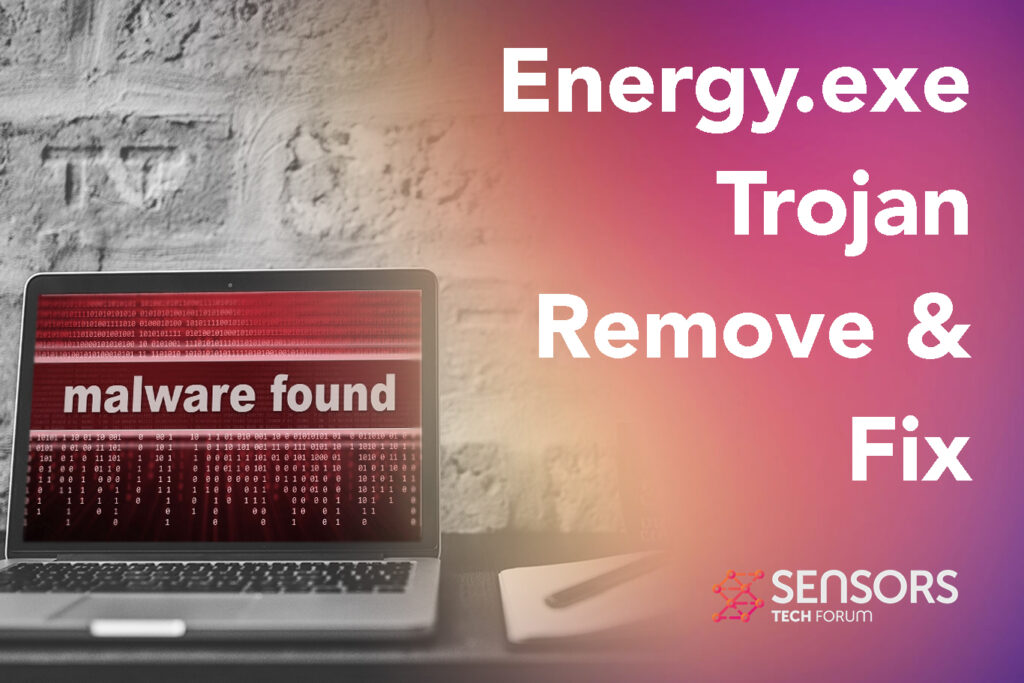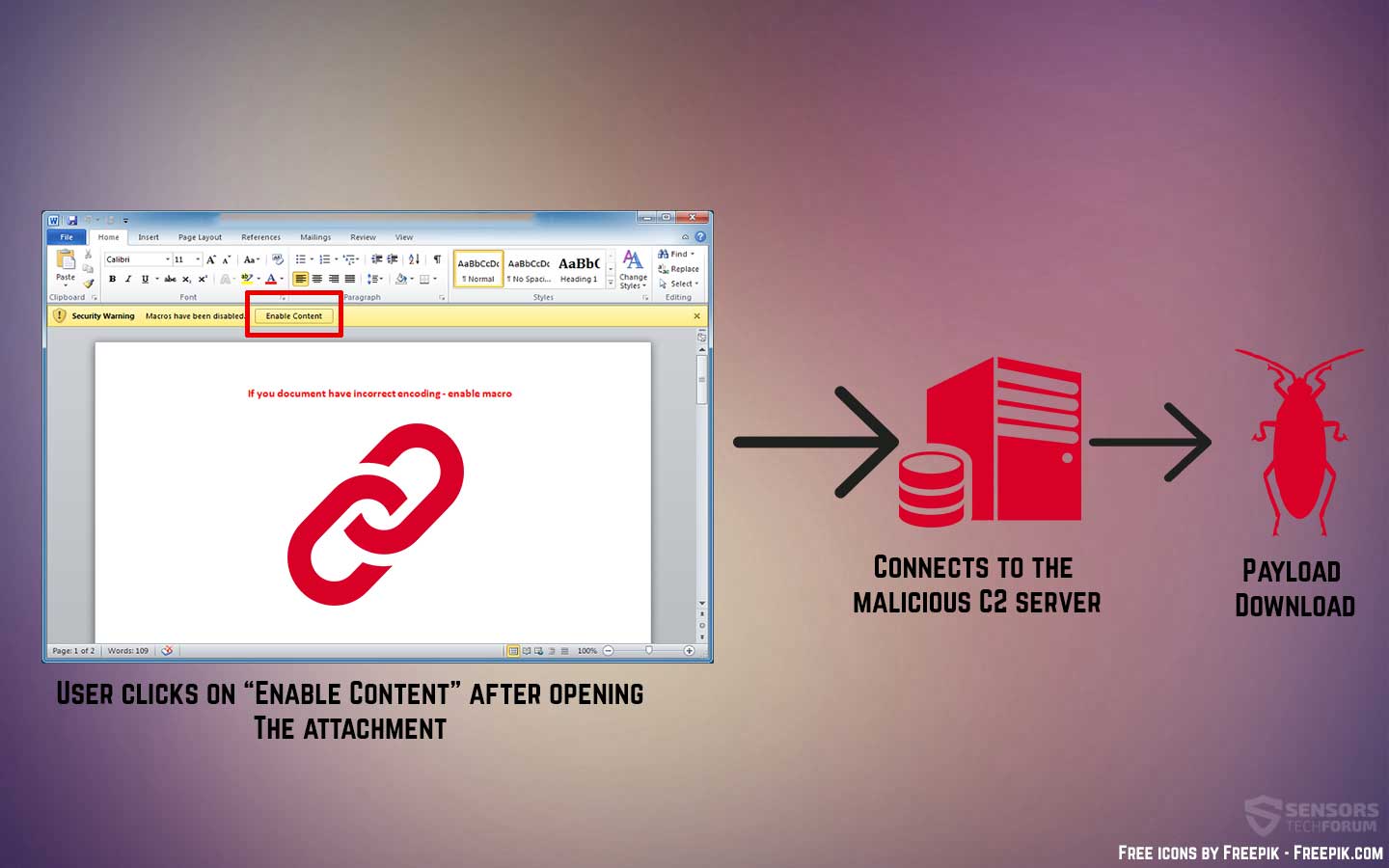What is Energy.exe?
Energy.exe is the name of malware, specifically detected as a nasty Trojan Horse. The main idea of this malware is to perform series of malicious activities on your computer without your authorisation. This could result in multiple negative consequences for your computer and the information in it, such as lead to information theft, damage of your data and other.
Read this article to learn more about Energy.exe and how to get rid of it completely from your computer system.

Energy.exe Summary
| Name | Energy.exe |
| Type | Trojan Horse |
| Brief Description | Aims to perform mining activities for BitCoin and spyware activities as well . |
| Symptoms | Your computer could become very slow and even freeze from time to time. |
| Distribution Technique | Bundled downloads. Web pages which may promote it. |
| Detection Tool |
See if the System is impacted by Energy.exe
Down Load
Malware Removal Tool
|
User Experience | Join Our Forum to go over Energy.exe. |
Energy.exe Virus – Why Do I See It?
Energy.exe is a malicious software that may have been installed on your computer without your knowledge. It is designed to use your computer’s resources to mine cryptocurrency and send it to the attacker’s wallet. It is important to remove this virus as soon as possible to prevent further damage to your system.
Energy.exe Trojan – How Did I Get It?
Energy.exe is the name of a Trojan horse, and is very similar to the Bloom.exe, SharkBot and Trojan.Win32.PDF.Alien.gen viruses.
One of the ways this malware can cause an infection on your computer is by being featured as a file attached to an e-mail sent to you. There, this file may seem like a document that is very important, like an invoice or an e-ticket for example. When such a document is downloaded and opened, it may ask you to enable the contents of it. This may trigger malicious macros infection, similar to what the graphic below shows:
Energy.exe Virus – What Does It Do?
Once Energy.exe has infected your computer, it may run different malicious functions, for example a Bitcoin Miner virus.
Other activities of this Trojan include downloading malicious files and creating mutexes without you realising it. The main outcome of this activity is the files to exist in the following directory in Windows:
- %AppData%/Roaming/Energy
Among the malicious activities of the Energy.exe Trojan may also be to create registry entries in the Run and RunOnce, sub-keys, shown below:
HKEY_LOCAL_MACHINE\Software\Microsoft\Windows\CurrentVersion\Run
HKEY_LOCAL_MACHINE\Software\Microsoft\Windows\CurrentVersion\RunOnce
HKEY_CURRENT_USER\Software\Microsoft\Windows\CurrentVersion\Run
HKEY_CURRENT_USER\Software\Microsoft\Windows\CurrentVersion\RunOnce
This will allow the Trojan to run automatically each time you start Windows.
Energy.exe – Is It a Virus?
Energy.exe miner Trojan is a malicious software that uses your computer’s resources to mine for cryptocurrency without your knowledge. It is considered a virus as it can cause harm to your system and can be difficult to detect and remove.
Energy.exe – Is It Dangerous?
Energy.exe may be dangerous to your computer in the same way like any other nasty Trojan, which is characterised by the following malicious activities it could perform without your consent:
- Download other viruses.
- Update its miners, control them.
- Take screenshots.
- Steal files.
- Log the keystrokes you type.
- Obtain data from your PC.
- Control your microphone and audio.
Keep reading this article to find out more information about Energy.exe and how to delete it completely from your computer system.
Remove Energy.exe Virus from Your Computer
The best course of action if you believe that your computer is compromised by Energy.exe is to get rid of it automatically by scanning your machine using a professional anti-malware software. Such a program has been specifically created with the primary purpose to help delete this virus by thoroughly checking your device for all kinds of malicious objects and fully cleaning it up, plus ensuring it is protected in the future, too.
Energy.exe can be deleted from your computer by following the removal guide beneath. It has been created mainly to help get rid of malicious software from your machine both in manual and automatic approaches.
Preparation before removing Energy.exe.
Before starting the actual removal process, we recommend that you do the following preparation steps.
- Make sure you have these instructions always open and in front of your eyes.
- Do a backup of all of your files, even if they could be damaged. You should back up your data with a cloud backup solution and insure your files against any type of loss, even from the most severe threats.
- Be patient as this could take a while.
- Scan for Malware
- Fix Registries
- Remove Virus Files
Step 1: Scan for Energy.exe with SpyHunter Anti-Malware Tool



Step 2: Clean any registries, created by Energy.exe on your computer.
The usually targeted registries of Windows machines are the following:
- HKEY_LOCAL_MACHINE\Software\Microsoft\Windows\CurrentVersion\Run
- HKEY_CURRENT_USER\Software\Microsoft\Windows\CurrentVersion\Run
- HKEY_LOCAL_MACHINE\Software\Microsoft\Windows\CurrentVersion\RunOnce
- HKEY_CURRENT_USER\Software\Microsoft\Windows\CurrentVersion\RunOnce
You can access them by opening the Windows registry editor and deleting any values, created by Energy.exe there. This can happen by following the steps underneath:


 Tip: To find a virus-created value, you can right-click on it and click "Modify" to see which file it is set to run. If this is the virus file location, remove the value.
Tip: To find a virus-created value, you can right-click on it and click "Modify" to see which file it is set to run. If this is the virus file location, remove the value.Step 3: Find virus files created by Energy.exe on your PC.
1.For Windows 8, 8.1 and 10.
For Newer Windows Operating Systems
1: On your keyboard press + R and write explorer.exe in the Run text box and then click on the Ok button.

2: Click on your PC from the quick access bar. This is usually an icon with a monitor and its name is either “My Computer”, “My PC” or “This PC” or whatever you have named it.

3: Navigate to the search box in the top-right of your PC's screen and type “fileextension:” and after which type the file extension. If you are looking for malicious executables, an example may be "fileextension:exe". After doing that, leave a space and type the file name you believe the malware has created. Here is how it may appear if your file has been found:

N.B. We recommend to wait for the green loading bar in the navigation box to fill up in case the PC is looking for the file and hasn't found it yet.
2.For Windows XP, Vista, and 7.
For Older Windows Operating Systems
In older Windows OS's the conventional approach should be the effective one:
1: Click on the Start Menu icon (usually on your bottom-left) and then choose the Search preference.

2: After the search window appears, choose More Advanced Options from the search assistant box. Another way is by clicking on All Files and Folders.

3: After that type the name of the file you are looking for and click on the Search button. This might take some time after which results will appear. If you have found the malicious file, you may copy or open its location by right-clicking on it.
Now you should be able to discover any file on Windows as long as it is on your hard drive and is not concealed via special software.
Energy.exe FAQ
What Does Energy.exe Trojan Do?
The Energy.exe Trojan is a malicious computer program designed to disrupt, damage, or gain unauthorized access to a computer system.
It can be used to steal sensitive data, gain control over a system, or launch other malicious activities.
Can Trojans Steal Passwords?
Yes, Trojans, like Energy.exe, can steal passwords. These malicious programs are designed to gain access to a user's computer, spy on victims and steal sensitive information such as banking details and passwords.
Can Energy.exe Trojan Hide Itself?
Yes, it can. A Trojan can use various techniques to mask itself, including rootkits, encryption, and obfuscation, to hide from security scanners and evade detection.
Can a Trojan be Removed by Factory Reset?
Yes, a Trojan can be removed by factory resetting your device. This is because it will restore the device to its original state, eliminating any malicious software that may have been installed. Bear in mind, that there are more sophisticated Trojans, that leave backdoors and reinfect even after factory reset.
Can Energy.exe Trojan Infect WiFi?
Yes, it is possible for a Trojan to infect WiFi networks. When a user connects to the infected network, the Trojan can spread to other connected devices and can access sensitive information on the network.
Can Trojans Be Deleted?
Yes, Trojans can be deleted. This is typically done by running a powerful anti-virus or anti-malware program that is designed to detect and remove malicious files. In some cases, manual deletion of the Trojan may also be necessary.
Can Trojans Steal Files?
Yes, Trojans can steal files if they are installed on a computer. This is done by allowing the malware author or user to gain access to the computer and then steal the files stored on it.
Which Anti-Malware Can Remove Trojans?
Anti-malware programs such as SpyHunter are capable of scanning for and removing Trojans from your computer. It is important to keep your anti-malware up to date and regularly scan your system for any malicious software.
Can Trojans Infect USB?
Yes, Trojans can infect USB devices. USB Trojans typically spread through malicious files downloaded from the internet or shared via email, allowing the hacker to gain access to a user's confidential data.
About the Energy.exe Research
The content we publish on SensorsTechForum.com, this Energy.exe how-to removal guide included, is the outcome of extensive research, hard work and our team’s devotion to help you remove the specific trojan problem.
How did we conduct the research on Energy.exe?
Please note that our research is based on an independent investigation. We are in contact with independent security researchers, thanks to which we receive daily updates on the latest malware definitions, including the various types of trojans (backdoor, downloader, infostealer, ransom, etc.)
Furthermore, the research behind the Energy.exe threat is backed with VirusTotal.
To better understand the threat posed by trojans, please refer to the following articles which provide knowledgeable details.














